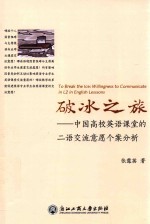

破冰之旅 中国高校英语课堂的二语交流意愿个案分析PDF电子书下载
- 电子书积分:11 积分如何计算积分?
- 作 者:张露茜著
- 出 版 社:杭州:浙江工商大学出版社
- 出版年份:2015
- ISBN:751781477X
- 页数:277 页
List of Tables 1
List of Figures 1
Chapter 1:Introduction 1
1.1 Research problem 1
1.2 Research motive 3
1.3 Research aim and questions 4
1.4 Significance of the study 5
1.5 Outline of this thesis 6
Chapter 2:Chinese Context 8
2.1 English in China 8
2.1.1 China English 13
2.2 College English 17
2.3 Willingness to Communicate(WTC) 19
2.4 Conclusion 22
Chapter 3:Literature Review 23
3.1 Establishment of WTC in L1 24
3.2 Establishment of WTC in L2 28
3.3 Development of L2 WTC studies and theories 31
3.3.1 Recent L2 WTC studies outside China 35
3.3.2 Recent L2 WTC studies in China 43
3.4 The Chinese WTC model 52
3.4.1 Factors in Chinese WTC model 52
3.4.2 Challenged collectivistic outlook of the Chinese 63
3.5 Conclusion 64
Chapter 4:Methodology 66
4.1 Research design 66
4.1.1 Procedures 69
4.2 The case study approach 70
4.3 Research setting and participants 72
4.4 Instruments 74
4.4.1 Questionnaires 74
4.4.2 Documents 78
4.4.3 Student narratives 81
4.4.4 Classroom observations 82
4.4.5 Stimulated recalls 84
4.4.6 Semi-structured interviews 85
4.5 Data analysis procedures 88
4.6 Ethical issues 91
Chapter 5:Pilot Study 93
5.1 Pilot Study One 93
5.2 Pilot Study Two 95
5.2.1 Data screen 95
5.2.2 Exploratory Factor Analysis(EFA) 97
Chapter 6:Study One 105
6.1 Data screen 105
6.2 Findings 107
6.2.1 Confirmatory Factor Analysis(CFA) 108
6.2.2 Multi-group Confirmatory Factor Analysis(MGCFA) 112
6.2.3 Structural Equation Modeling(SEM) 118
6.2.4 Multi-group Structural Equation Modeling(MGSEM) 124
6.3 Discussion 130
6.3.1 Research Questions One:Personal factors that facilitate and hinder BE students'WTC and Three:Interactions between personal and contextual factors 133
6.3.2 Research Question Four:Pedagogical changes 138
6.4 Conclusion 140
Chapter 7:Study Two 142
7.1 Participant information in qualitative studies 142
7.2 Document analysis outcomes 144
7.3 Classroom observation findings 147
7.4 Teacher interview results 156
7.4.1 Teacher with weak classroom context 157
7.4.2 Teacher with supportive classroom context 160
7.5 Discussion 163
7.5.1 Research Question Two:Contextual factors that facilitate and hinder BE students'WTC 164
7.5.2 Research Question Three:Interactions between personal and contextual factors 168
7.5.3 Research Question Four:Pedagogical changes 169
Chapter 8:Study Three 173
8.1 Student narratives 173
8.1.1 High WTC and weak context 175
8.1.2 High WTC and supportive context 177
8.1.3 Low WTC and weak context 179
8.1.4 Low WTC and supportive context 181
8.2 Stimulated Recalls 183
8.3 Student interviews 185
8.3.1 Societal context 187
8.3.2 Personality 189
8.3.3 Motivation 191
8.3.4 Attitudes 193
8.4 Discussion 195
8.4.1 Research Question One:Personal factors that facilitate and hinder BE students'WTC 195
8.4.2 Research Question Three:Interactions between personal and contextual factors 199
8.4.3 Research Question Four:Pedagogical changes 200
Chapter 9:Discussion 205
9.1 Combining findings 205
9.1.1 A three-dimension Chinese L2 WTC model 205
9.1.2 Data combining outcomes 208
9.2 Relating findings with previous L2 WTC studies 211
9.3 Lack of teacher support 212
Chapter 10:Conclusions 216
10.1 Research mission of the study 216
10.2 Summary of findings 218
10.2.1 Research Question One:Personal factors that facilitate and hinder BE students'WTC 219
10.2.2 Research Question Two:Contextual factors that facilitate and hinder BE students'WTC 221
10.2.3 Research Question Three:Interactions between personal and contextual factors 223
10.2.4 Research Question Four:Pedagogical changes 224
10.3 Limitations and future research 227
10.4 Conclusion 228
References 230
Appendix A:WTC Questionnaires in spoken English in English language classrooms 260
Appendix B:Classroom observation sheet 268
Appendix C:Stimulated recall questions 269
Appendix D:Interview questions with BE students 270
Appendix E:Interview questions with English teachers 273
Appendix F:Thematic coding of qualitative data 274
Appendix G:A sample student narrative 275
- 《绕着地球跑一圈 第4辑 欧洲之旅 意大利》稚子文化编绘 2018
- 《课堂上听不到的历史传奇 世界政治军事名人 初中版》顾跃忠等编著 2015
- 《孩子们的音乐之旅 1 宝宝睡觉 幼儿版》包菊英主编 2016
- 《全国校外艺术课堂新形态示范教材系列 少儿钢琴表演曲集》唐冠祥编著 2019
- 《孩子们的音乐之旅 4 奇妙世界 幼儿版》包菊英主编 2016
- 《近代民营出版机构的英语函授教育 以“商务、中华、开明”函授学校为个案 1915年-1946年版》丁伟 2017
- 《孩子们的音乐之旅 1 音乐故事 儿童版》包菊英主编 2019
- 《语文第二课堂 平凡的日子》曹文轩 2019
- 《语文第二课堂 未来的路上》曹文轩 2019
- 《高中英语高效课堂的实践与应用》黄玉红,邱少权,张建新主编 2018
- 《中风偏瘫 脑萎缩 痴呆 最新治疗原则与方法》孙作东著 2004
- 《水面舰艇编队作战运筹分析》谭安胜著 2009
- 《王蒙文集 新版 35 评点《红楼梦》 上》王蒙著 2020
- 《TED说话的力量 世界优秀演讲者的口才秘诀》(坦桑)阿卡什·P.卡里亚著 2019
- 《燕堂夜话》蒋忠和著 2019
- 《经久》静水边著 2019
- 《魔法销售台词》(美)埃尔默·惠勒著 2019
- 《微表情密码》(波)卡西亚·韦佐夫斯基,(波)帕特里克·韦佐夫斯基著 2019
- 《看书琐记与作文秘诀》鲁迅著 2019
- 《酒国》莫言著 2019
- 《大学计算机实验指导及习题解答》曹成志,宋长龙 2019
- 《浙江海岛植物原色图谱》蒋明,柯世省主编 2019
- 《大学生心理健康与人生发展》王琳责任编辑;(中国)肖宇 2019
- 《大学英语四级考试全真试题 标准模拟 四级》汪开虎主编 2012
- 《大学英语教学的跨文化交际视角研究与创新发展》许丽云,刘枫,尚利明著 2020
- 《复旦大学新闻学院教授学术丛书 新闻实务随想录》刘海贵 2019
- 《大学英语综合教程 1》王佃春,骆敏主编 2015
- 《美丽浙江 2016 法语》浙江省人民政府新闻办公室编 2016
- 《二十五史中的浙江人 24》浙江省地方志编纂委员会编 2005
- 《大学物理简明教程 下 第2版》施卫主编 2020
